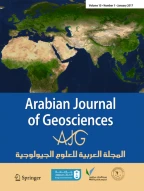Abstract
Anisotropy is one of the natural properties of layered fractured rock, and it plays an important role in slope stability analysis, which is a vital problem in the geotechnical engineering. However, in the present engineering design, rock mass is simply treated as isotropic material, which fails to take into account the anisotropic properties. This work begins with formulizations of the anisotropic seepage-stress coupled model for the layered fractured rock slope stability analysis based on the equivalent continuum theory. Next, the model is applied in the numerical simulation of the southern slope of an open-pit mine in China to understand the mechanism of the existing failure strain as well as the failure mechanism of the potential landslide. The computed water table and damage zone have been compared with the field measurements and found to be in good agreement with field observations. Finally, the effective measures to prevent the slope failure and strengthen the slope stability have been suggested. The proposed model successfully applied in the case study indicated that it is much more feasible and efficient comparing with using the traditional isotropic coupled model in such layered fractured rock slopes stability problems.












Similar content being viewed by others
References
Amadei B (1996) Importance of anisotropy when estimating and measuring in situ stresses in rock. Int J Rock Mech Min Sci 33(3):293–325
Baker R (1980) Determination of the critical slip surface in slope stability computation. Int J Numer Anal Methods Geomech 4(4):333–359
Biot MA (1941) General theory of three-dimensional consolidation. J Appl Phys 12:155–164
Bishop AW (1955) The use of the slip circle in the stability analysis of slope. Geotechnique 5(1):7–17
Choi SO, Chung SK (2004) Stability analysis of jointed rock slopes with the barton–bandis constitutive model in UDEC. Int J Rock Mech Min Sci 41:581–586
Cundall PA, Strack ODL (1979) A discrete numerical model for granular assemblies. Geotechnique 29(1):47–65
Dawson EM, Roth WH, Drescher A (1999) Slope stability analysis by shear strength reduction. Geotechnique 49(6):835–840
Duncan JM (1996) State of the art: limit equilibrium and finite-element analysis of slopes. J Geotech Eng 122:577–596
Gonzaga GG, Leite MH, Corthésy R (2008) Determination of anisotropic deformability parameters from a single standard rock specimen. Int J Rock Mech Min Sci 45(8):1420–1438
Griffiths DV, Lane PA (1999) Slope stability analysis by finite elements. Geotechnique 49(3):387–403
Janbu N (1954) Application of composite slip surfaces for stability analysis. Proc Eur Conf Stab Earth Slopes 3:43–49
Louis C (1972) Rock hydraulics. Rock Mech 165:299–387
Nunes ALLS (2002) A new method for determination of transverse isotropic orientation and the associated elastic parameters for intact rock. Int J Rock Mech Min Sci 39(2):257–273
Pariseau WG (1999) An equivalent plasticity theory for jointed rock masses. Int J Rock Mech Min Sci 36(7):907–918
Pradhan SP, Vishal V, Singh TN (2011) Stability of slope in an open cast mine in Jharia Coalfield, India—a slope mass rating approach. Min Eng J 12(10):36–40
Pradhan SP, Vishal V, Singh TN, Singh VK (2014) Optimisation of dump slope geometry vis-à-vis flyash utilization using numerical simulation. Am J Min Metall 2(1):1–7
Sarkar K, Singh TN, Verma AK (2012) A numerical simulation of landslide-prone slope in Himalayan Region—a case study. Arab J Geosci 5:73–81
Singh TN, Gulati A, Dontha L, Bhardwaj V (2008) Evaluating cut slope failure by numerical analysis—a case study. Nat Hazards 47:263–279
Singh TN, Pradhan SP, Vishal V (2013) Stability of slopes in a fire-prone mine in Jharia Coalfied, India. Arab J Geosci 6:419–427
Snow DT (1969) Anisotropic permeability of fractured media. Water Resour Res 5(6):1273–1289
Spencer E (1967) A method of analysis of the stability of embankments assuming parallel inter-slice forces. Geotechnique 17(1):11–26
Terzaghi K, Peck RB, Mesri G (1996) Soil mechanics in engineering practice. Wiley, New York
Vishal V, Pradhan SP, Singh TN (2010) Instability assessment of mine slope—a finite element approach. Int J Earth Sci Eng 3:11–23
Wang C, Tannant DD, Lilly PA (2003) Numerical analysis of the stability of heavily jointed rock slopes using PFC2D. Int J Rock Mech Min Sci 40:415–424
Wang PT, Yang TH, Xu T, Yu QL, Liu HL (2013a) A model of anisotropic property of seepage and stress for jointed rock mass. J Appl Math. doi:10.1155/2013/420536
Wang PT, Yang TH, Zhu LK, Liu HL (2013b) Strength reduction method for rock slope stability analysis based on PFC2D. J Northeast Univ (Nat Sci) 34(1):127–130
Yang TH, Jia P, Shi WH et al (2014) Seepage-stress coupled analysis on anisotropic characteristics of fractured rock mass around roadway. Tunn Undergr Space Technol. doi:10.1016/j.tust.2014.03.005
Zhang GK (2006) Study on equivalent orthotropic mechanical parameters and yield criterion of jointed rock mass and its engineering application. Hohai University, Nanjing
Zheng H, Liu DF, Li CG (2005) Slope stability analysis based on elasto-plastic finite element method. Int J Numer Methods Eng 64(14):1871–1888
Acknowledgments
We thank the engineers of China West Open-pit Mine of Fushun Mining Group and Shenyang Branch of China Coal Research Institute for their geological data of this study. This research is financially supported by the National Science Foundation of China (Grant No. 51174045, 51034001), the basic scientific research funds of Ministry of Education of China (No. N120601002), and the Specialized Research Fund for the Doctoral Program of Higher Education of China (Grant No. 20120042120053) also give financial support to this research.
Author information
Authors and Affiliations
Corresponding author
Rights and permissions
About this article
Cite this article
Yang, Th., Shi, Wh., Wang, Pt. et al. Numerical simulation on slope stability analysis considering anisotropic properties of layered fractured rocks: a case study. Arab J Geosci 8, 5413–5421 (2015). https://doi.org/10.1007/s12517-014-1609-2
Received:
Accepted:
Published:
Issue Date:
DOI: https://doi.org/10.1007/s12517-014-1609-2



